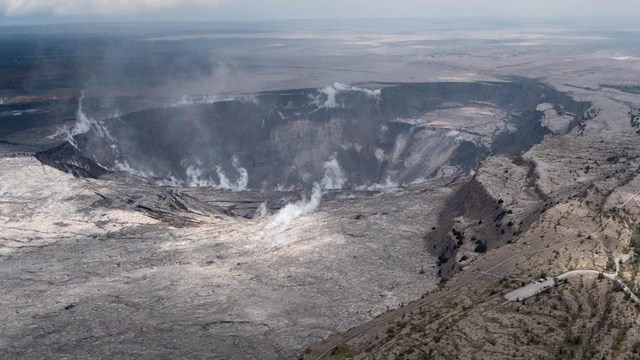Last updated: January 20, 2021
Article
Pele

Pele is the Hawaiian volcano deity, an elemental force, and the creator of these volcanic landscapes. According to tradition, she is embodied by the lava and natural forces associated with volcanic eruptions.
Oral history says that Pele was born in the distant land of Kahiki and voyaged to the Hawaiian Islands in search of a suitable home. Various accounts place this journey some time between 850 and 1250 AD. She migrated southeast through the islands, eventually arriving at her permanent home in Halemaʻumaʻu crater at the summit of Kīlauea. From Halemaʻumaʻu, Pele dwells and governs the boundaries of Puna and Kaʻū.
Ancient Hawaiian oli (chants) tell the kuleana (function) of Pele - creating new land, but also destroying what was once there. She is both destructive and creative in nature. Names like Pelehonuamea (Pele of the red earth) and Peleʻaihonua (Pele the eater of the land) themselves are forms of historic accounts that describe her volcanic energy and movement. Her unpredictable and volatile nature has been visible throughout the centuries in the form of glowing lava lakes, earth-shaking fountains, and incandescent ribbons of fiery lava flowing down Kīlauea.
For many Hawaiians, Pele is considered ʻohana (family) and is revered. She is an ʻaumakua (family or deified ancestor) for some people of the districts of Puna and Kaʻū on the island of Hawaiʻi. Her presence can be felt by those who visit her volcanic domain and lives within the hearts and minds of those who experience her power. The presence of Pelehonuamea is not necessarily approached with fear, but with respect. When you visit Kīlauea, remember to do so respectfully. In Hawaiian tradition, it is customary to ask permission from Pele to travel through her land and this sacred landscape.
Oral history says that Pele was born in the distant land of Kahiki and voyaged to the Hawaiian Islands in search of a suitable home. Various accounts place this journey some time between 850 and 1250 AD. She migrated southeast through the islands, eventually arriving at her permanent home in Halemaʻumaʻu crater at the summit of Kīlauea. From Halemaʻumaʻu, Pele dwells and governs the boundaries of Puna and Kaʻū.
Ancient Hawaiian oli (chants) tell the kuleana (function) of Pele - creating new land, but also destroying what was once there. She is both destructive and creative in nature. Names like Pelehonuamea (Pele of the red earth) and Peleʻaihonua (Pele the eater of the land) themselves are forms of historic accounts that describe her volcanic energy and movement. Her unpredictable and volatile nature has been visible throughout the centuries in the form of glowing lava lakes, earth-shaking fountains, and incandescent ribbons of fiery lava flowing down Kīlauea.
For many Hawaiians, Pele is considered ʻohana (family) and is revered. She is an ʻaumakua (family or deified ancestor) for some people of the districts of Puna and Kaʻū on the island of Hawaiʻi. Her presence can be felt by those who visit her volcanic domain and lives within the hearts and minds of those who experience her power. The presence of Pelehonuamea is not necessarily approached with fear, but with respect. When you visit Kīlauea, remember to do so respectfully. In Hawaiian tradition, it is customary to ask permission from Pele to travel through her land and this sacred landscape.
Having been shared by many Hawaiians over long periods of time, different versions of moʻolelo may vary, in some cases significantly.

Pele & Lonomakua
How Lonomakua, the uncle of the volcanic deity, taught her to govern fire

Holo Mai Pele (The Journey of Pele)
The journey of Pele mirrors the geological formation of the Hawaiian Islands

Pele & Hiʻiaka
The saga of Hiʻiakaikapoliopele describes the journey of the favorite sister of Pele and an epic battle at the summit of Kīlauea
Read more about moʻolelo relating to Hawaiʻi Volcanoes National Park
